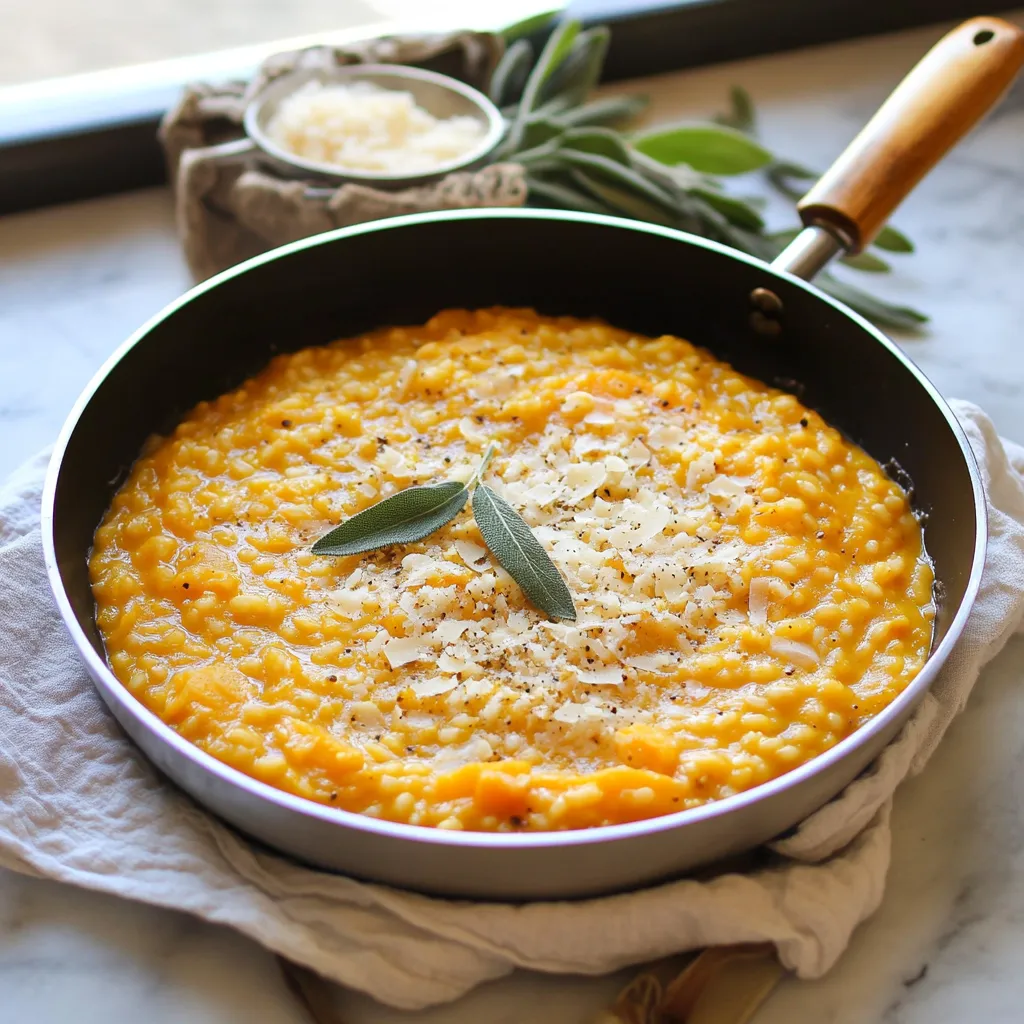 Pin it
Pin it
This butternut squash risotto transforms simple ingredients into a luxurious, creamy Italian dish that's perfect for fall dinners. The natural sweetness of butternut squash melts into the rice, creating a velvety texture and gorgeous golden color that makes this comfort food both elegant and satisfying.
I discovered this recipe during a fall cooking class in Tuscany and have made it countless times since. The way the squash breaks down to create that signature creaminess always reminds me of that magical afternoon in the Italian countryside.
Ingredients
- Arborio rice: Specifically designed to release starch, giving risotto its signature creamy texture without cream
- Butternut squash: The star ingredient adds natural sweetness and creates the silky sauce as it cooks down
- White wine: Adds necessary acidity to balance the sweetness of the squash
- Fresh sage: Brings earthy aromatic quality that pairs perfectly with winter squash
- Chicken or vegetable stock: Hot stock helps coax the starch from the rice without shocking it with cold liquid
- Parmesan cheese: Provides that umami saltiness that elevates the entire dish
Step-by-Step Instructions
- Build the Flavor Base:
- Melt butter in a large skillet over medium heat until it begins to foam. Add diced onion and minced garlic, sautéing gently until translucent and fragrant but not browned. This process takes about 5 minutes and creates the essential foundation for your risotto.
- Season and Start the Squash:
- Add chopped sage along with salt and pepper, stirring to release the herb's oils. Introduce the butternut squash cubes and cook for 3 to 4 minutes until they begin to soften slightly at the edges. The squash will continue cooking throughout the process.
- Toast the Rice:
- Reduce heat to medium-low and add arborio rice to the pan, stirring continuously for about one minute. This crucial step toasts the rice grains, allowing them to maintain their structure while still releasing starch during cooking.
- Deglaze with Wine:
- Pour in white wine, stirring constantly as it sizzles and reduces. The wine adds acidity and depth while deglazing any flavorful bits from the bottom of the pan. Allow it to cook until nearly absorbed, about 5 minutes.
- Develop the Creamy Texture:
- Begin adding hot stock approximately half a cup at a time, stirring almost constantly between additions. Wait until each addition is nearly absorbed before adding more. This gradual process takes patience but creates the signature creamy texture as the rice releases its starch.
- Create the Silky Sauce:
- Continue the stock-adding process for about 20-25 minutes total. The squash will soften completely and begin to melt into the sauce, creating a naturally sweet, orange-tinted creamy mixture. The rice should be tender but with a slight bite in the center.
- Finish with Parmesan:
- Once all stock is incorporated and the rice is al dente, stir in freshly grated Parmesan cheese. This adds the final touch of salty richness that completes the dish. The consistency should be flowing but not soupy.
 Pin it
Pin it
This dish always reminds me of my first autumn in northern Italy where I learned that true risotto requires patience but not complexity. The transformation of humble squash into something so luxurious taught me that sometimes the most impressive dishes come from the simplest ingredients given proper time and attention.
The Secret to Perfect Texture
The key to achieving restaurant-quality risotto lies in maintaining the right heat and adding stock gradually. Too high heat rushes the cooking process, preventing proper starch release, while too low heat creates mushy grains. Medium-low heat allows for the perfect balance, letting each grain cook evenly while creating that signature creamy sauce. Remember that risotto should flow gently when served, not stand up like a mound of rice.
Seasonal Variations
While butternut squash creates the classic autumn version, this risotto adapts beautifully to other seasons. In spring, try fresh peas and mint for brightness. Summer calls for zucchini and basil, while winter welcomes mushrooms and thyme. The technique remains the same; only the starring vegetables change, making this a versatile recipe you can enjoy year-round with whatever produce looks best at your market.
Make Ahead Options
Though risotto is best served immediately, you can prepare components ahead of time. Cube your butternut squash and refrigerate up to three days in advance. You can even roast it separately to intensify the flavor. For partially made risotto, stop cooking when the rice is still quite firm, then spread on a baking sheet to cool. Refrigerate up to a day, then finish with additional hot stock when ready to serve, adding a splash of water if needed to loosen.
 Pin it
Pin it
With patience and the right technique, you'll transform simple ingredients into an elegant dish that's perfect for any occasion.
Frequently Asked Questions
- → Can I make this risotto ahead of time?
Risotto is best enjoyed immediately after cooking while it maintains its perfect creamy consistency. However, you can prepare the butternut squash ahead of time by peeling, cubing, and storing it in the refrigerator. If you must make the entire dish in advance, reheat gently with a splash of stock to restore creaminess.
- → Can I use a different type of squash?
Yes, pumpkin, acorn squash, or kabocha squash work beautifully as substitutes for butternut squash. Each will bring slightly different flavor notes but maintain the dish's creamy texture and orange hue.
- → Is constant stirring really necessary?
Yes, the constant stirring is crucial as it releases the starch from the arborio rice, creating the signature creamy texture of risotto. It also ensures even cooking and prevents sticking. This is the foundation of authentic risotto technique.
- → Can I make this vegan?
Absolutely! Substitute the butter with a plant-based alternative as mentioned in the ingredients. Replace the chicken stock with vegetable stock and either omit the Parmesan or use a vegan cheese substitute. Many nutritional yeast-based alternatives can provide a similar umami flavor.
- → Why use arborio rice specifically?
Arborio rice is essential for authentic risotto because of its high starch content. When cooked slowly with liquid, it releases this starch, creating the characteristic creamy consistency without becoming mushy. Other short-grain rice varieties like carnaroli or vialone nano can work, but regular long-grain rice won't deliver proper results.
- → What wine pairs best with butternut squash risotto?
A medium-bodied white wine with good acidity balances the creaminess of this dish perfectly. Try a Pinot Grigio, unoaked Chardonnay, or Vermentino. The same wine you use in cooking makes a natural pairing choice for serving.
